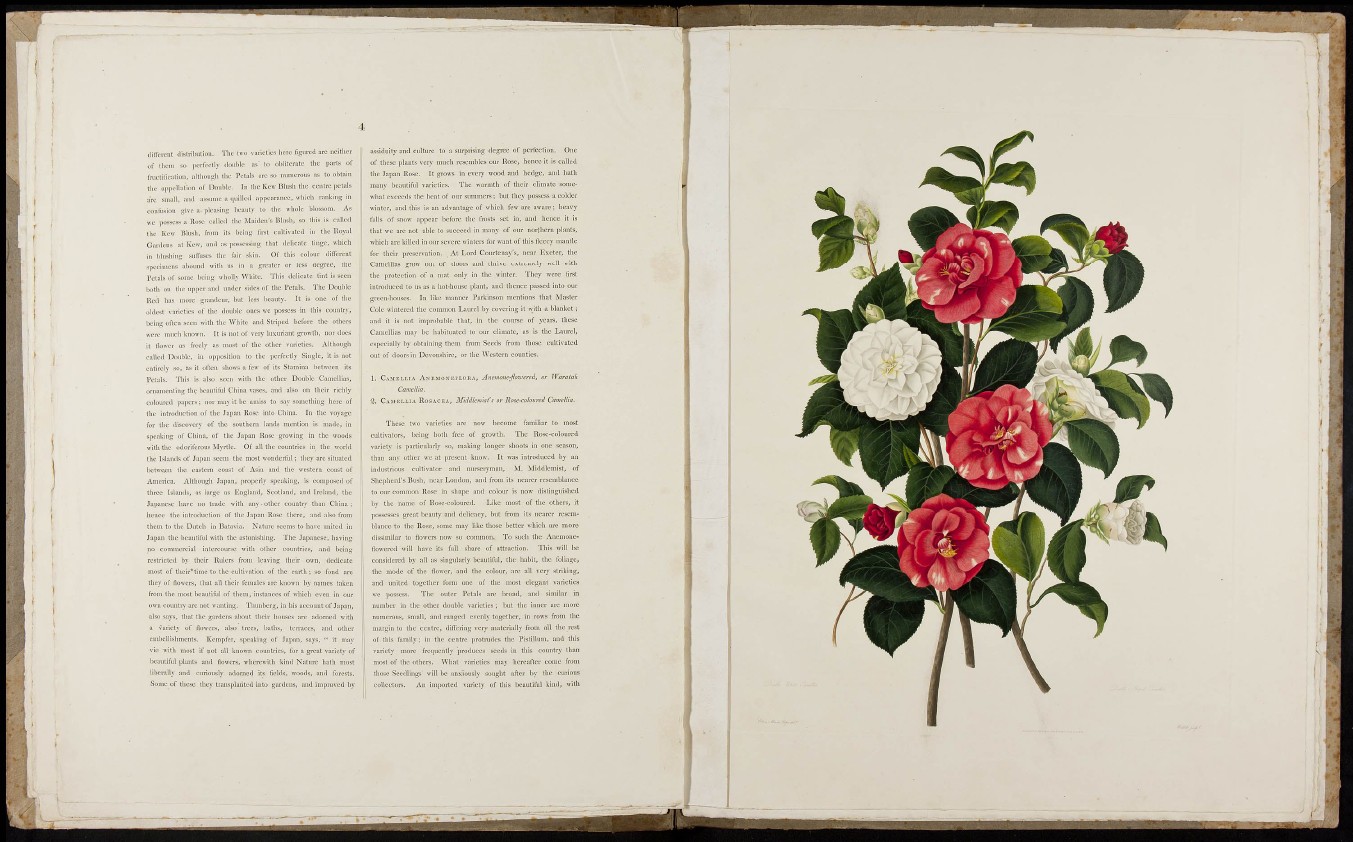
iliffcrcnl ilislrihulioii. The Iwo vuriclics liero figured arc iicillicr
of tliciii ^o pci-lcclly double iis' lo obliterate tlic parls of
rniclilicatlon, altliough the Pct;ils luc so mimerons ¡is lo obwin
the ¡i|)l)ell:ilion of Double. In tlic Kc«- Blush the centre petals
;ire smnll, and assume a <]uillccl iijipcnriuiee, which ranking in
eonlusioii give a- pleasing bcaulj' lo ihe whole blossom. As
« C possess a Uose ealled tlic Maiden's ISlnsii, so Ibis is called
tlie Kew Hhisii. froiii its being lirsl eiiUivate<l in llie Royal
Gardens at Kcw, and as possessing that dclieatc lingc. ubicli
ill blushing' sufluscs the fair skin. Ol" Ibis colour different
specimens aboinid with us in a grcali;r or less degree, the
Petals of sonic being « liollj' White. This delicate tint is seen
both on the upper and uniler sides ol' tlie Petals, 'J'lie Double
Retl bas more grandeiir, but less beauty. It is one of (be
oldest varieties of tlie double ones «'e possess in this comitry,
being often seen with the ^Vhitc and Striped before the others
wcie mvieh knovn. It is not of very Uixurlanl growth, nor docs
it ilovcr as freely as most of the other varieties. Although
called Douille, in opposition to the perfectly Single, it is not
entirely so. as it often shows a few of its Stamina between its
Petals. This is also seen with the other Double Camellias,
ornamenting the beautiful China vases, and also on their richly
coloured papers; nor may it be amiss to say something here of
tl>c introduction of the .Tapan Rose into Ciiina. In the voyage
for the discovery of the southern lands mention is made, in
speaking of China, of tlie Japan Rose growing in the woods
with the odoriferous Myrtle. Of all the countries in the ii'orld
the Islanils of Jai>an seem the most wonderful ; they are situated
between the eastern const of Asia and ibc western coast of
America. Although Japan, properly speaking, is composed of
three Islands, as large ns Engliind, Scotland, anil Ireland, Ihe
Japanese have mi trade with any. other country than China;
hence the introduction of the Japan Rose there, and also from
them to the Dutch in Hatavia. Nature seems to have nnited in
Japan the beautiful with the astonishing. Tlie Japanese, having
no commercial intercourse with other countries, and being
restricted by their Riders from leaving their own. dedicate
most of their'time to the cultivation of the earth ; so -fond are
they of flowci-s, that all their females arc knoM'n by names taken
from the most beautiful of them, instances of which even in our
own country arc not ^^•anting- Tliimbersr, in his account of Jajian,
also says, that the gardens about their houses are adorned with
a variety of tlowers, also trees, baths, terraces, and other
emiiellishineiits- liempt'cr, speaking of Japan, says, " it may
vie with most if not all known countries, for a great variety of
beautiful plants anil flowers, wlierewith kind Kaliirc iialh most
liberally and curiously adorned its lields, woods, and forests.
Some of tiiese they transplanted into gardens, and improved by
assiduity and culture to a surprising degree of perfection. One
of these plants very much resembles our Rose, hence it is called
the Japan Rose. It grows in every wood and hedge, and iiatlv
manv beautiful varieties. The warmth of their climate somewhat
exceeds the heat of our summers ; but they possess a colder
winter, and this is an advantage of which few arc aware; heavy
falls of sno«- appear before the frosts set in, and hence it is
Ibat we are not able to succeed In many of our iiorlhern plants,
which are killed in our severe winters for want of this fleecy mantle
for their pi-eservalion. . At Lord Coiirtenay's. near Exeter, Ihe
Camellias grow out of doors and thrive extremely -vicll with
the protection of a mat only in the winter. They were lii-st
introduced to us as a hot-house plant, and thence passed into our
green-houses. In like manner Parkinson mentions tiiat Master
Cole wintered the common Laurel by covering it with a blanket;
and it is not improbable that, in the course of years, these
Camellias may be habituated to our climatc, as is tiic Laurel,
especially by obtaining I hem from Seeds from tiiosc cultivated
out ol" doors ill Devonshire, or the ^Vestcrn counties.
1. CAMELLIA ANKMONEPLOHA, Anemoiie-Jlowcred, or Waratah
Camellia.
2. CAMELLI.V ROSACBA. Middlemist's or Rose-coloumI Camellia.
These t^vo varieties are now become familiar to most
cultivators, being both I'ree of growth. The Rosc-coloured
variety is particularly so, making longer shoots in one season,
than anv other we at present know. It was introduced by an
industrious cultivator and nurseryman, M. Middlemist, of
Shepherd's Hush, near London, and from its nearer resemblance
to onr common Rose in shape and colour is now distinguished
by the name of Rose-coloured. Like most of the others, it
possesses great beauty and delicacy, but from its nearer resemblance
to the Rose, some may like those better which are more
dissimilar to flowers now so common.. To such the Anemonedowered
will have its full share of attraction. This will be
considered by all as singularly beautiful, the habit, tlie foliage,
the mode of the flower, and the colour, arc all very striking,
and united together form one of the most elegant varieties
we possess. Tiic outer Petals are iiroad, and similar in
number in the other double varieties; but the inner are more
numerous, small, and ranged evenly together, in rows from the
margin lo the centre, difl'oriug very materially from all ihe rest
of tliis family ; in the centre protrudes the Pistillum, and this
variety more frequently produces seeds in Ihis country tiian
most of Ihe others. What varieties may hereafter eorac from
those Seedlings will be anxiously sought after by the curious
collectors. An imported variety of this beautiful kind, with